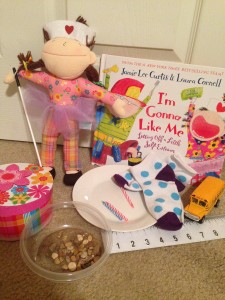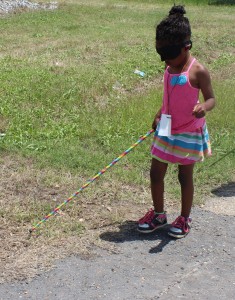

Latest posts by Corbb O'Connor (see all)
- New research: Proposed, global standard for quiet cars won’t benefit average blind person - June 30, 2015
- Learning to Type with a Simple ‘Keystroke’ - October 28, 2014
- Unique Certification Organization Recognized with $20,000 Award - July 29, 2014
- Help Blind People Combat the Tendency to Rock Back and Forth - July 16, 2014
- Routine Class Project Changes First Grader’s Mind - June 12, 2014
A first-grader with low vision, who has so far been reluctant to use a cane, now cannot wait until she gets her first cane after using a “story box” created by Paige Morra, a graduate student in the Teaching Blind Students program at Louisiana Tech University.
Based upon the book “I’m Gonna Like Me” by Jamie Lee Curtis, the story box contains an assortment of manipulatives representing items that are mentioned or described in the book. When teachers come to a page marked with an icon of a box, they can introduce the tactile object to the child. If the child is familiar with the objects, it can also be fun to have the student find the object while reading the story.
The story boxes help connect words to their meanings, said instructor Laura Bostick, MA, NCLB.
“For sighted kids who are just learning to read, illustrations in a book help give meaning to the words,” Bostick said. “The real objects in a story box are a blind kid’s illustrations. They teach concepts and help the child begin to make the connection that braille has meaning. They also make early literacy experiences a lot more fun.”
Morra’s box included the main objects of the story and even some that were just mentioned once.
 “The beginning of the story mentions the girl’s braids,” Morra said. “For this, I found the doll that goes with the book, and she has many braids on top of her head. For the bus that is mentioned, I found a toy school bus that, even though it is miniature, is a good depiction of an actual school bus. The toy school bus is made of metal, has rubber tires, has doors that can open and shut, and even has a hood that can pop open to see and feel the engine.”
“The beginning of the story mentions the girl’s braids,” Morra said. “For this, I found the doll that goes with the book, and she has many braids on top of her head. For the bus that is mentioned, I found a toy school bus that, even though it is miniature, is a good depiction of an actual school bus. The toy school bus is made of metal, has rubber tires, has doors that can open and shut, and even has a hood that can pop open to see and feel the engine.”
Other objects in the box included print-braille alphabet magnets, a braille ruler, a get-well card, a plastic ring, a glass plate, and even a plastic container of dirt and pebbles!
Most importantly for this student, the doll was holding a white cane made from a dowel rod. After seeing the doll, the student asked, “Can my next prize on the reward board be a cane? Princesses need canes!”
“It was just something extra I added to the box, even though it is not mentioned in the story,” Morra said. “I was so excited to hear that one of the outreach students decided she wanted a cane because of this!”
Bostick teaches the Developmental Aspects of Blindness course, which is required for all graduate students in both the Teaching Blind Students and Orientation & Mobility programs at Louisiana Tech. The story box project, she said, brings together some of the course’s main themes.
 “We talk about how development may be delayed in blind kids if we don’t find ways to motivate them and get them moving and exploring,” she said. “We look at typical physical, cognitive, and psychosocial development in children from birth through adolescence, how this development might be affected by blindness, and how to keep the blind child on track developmentally.”
“We talk about how development may be delayed in blind kids if we don’t find ways to motivate them and get them moving and exploring,” she said. “We look at typical physical, cognitive, and psychosocial development in children from birth through adolescence, how this development might be affected by blindness, and how to keep the blind child on track developmentally.”
As for the outreach student, the epiphany came just a few weeks before she attended the Braille Enrichment for Literacy and Learning (NFB-BELL) program, during which she received her cane and had her first orientation and mobility lessons.


Latest posts by Corbb O'Connor (see all)
- New research: Proposed, global standard for quiet cars won’t benefit average blind person - June 30, 2015
- Learning to Type with a Simple ‘Keystroke’ - October 28, 2014
- Unique Certification Organization Recognized with $20,000 Award - July 29, 2014
- Help Blind People Combat the Tendency to Rock Back and Forth - July 16, 2014
- Routine Class Project Changes First Grader’s Mind - June 12, 2014
